Your case involves the death of one or more individuals. An autopsy or autopsies may or may not have been performed. Your clinical experts are firm in their opinions regarding the standard of care and appropriate diagnostic and therapeutic modalities. There are other issues, however, where doubts or confusion may exist. Here is where an experienced forensic pathologist may be of invaluable assistance.
Below are some problems that can typically benefit from a forensic pathology expert.
Causation
The definition for the cause of death that I have relied upon for decades is “the disease or injury or combination thereof, that initiates an ultimately lethal train of events and without which death would not have occurred.” In a significant number of deaths, the cause is quite clear – widely metastatic cancer, myocarditis, gunshot wounds of the head, etc. In other situations, however, the ultimately lethal train of events may be quite long, with the expertise required to sort out the immediate and proximate (or underlying) cause of death with potentially other contributing factors along the way. Repeated studies over many years have consistently demonstrated the unreliability of death certificates filed by clinicians improperly trained in accurate death certification. Look at the previously published journal posts devoted to proper death certification. The medical specialist most optimally positioned to separate the wheat from the chaff is a forensic pathologist. This is particularly the case in delayed deaths following a traumatic injury. Was the death due to or contributed to by the injury? Was the death due to causes entirely independent of the injury? The implications of this distinction can be immense in both criminal and civil proceedings. Be willing to question death certificates, but do so with an expert who knows the territory.
Patterns and mechanisms of injury
Integral to the practice of forensic pathology is pattern recognition and correlation. This applies to patterns of injury both externally and internally. More detailed posts regarding these issues are among the journal entries on this site,
Gunshot wounds – Entrance versus exit wounds can occasionally be mistaken by emergency personnel and even trauma surgeons on occasion. A forensic pathologist who has examined thousands of gunshot wounds can lend valuable assistance when these issues arise. The range of fire of a gunshot wound may be in dispute in a given case. Gross and microscopical analysis of injuries by a forensic pathologist can be critical in cases wherein conflicting witness statements are on the record.
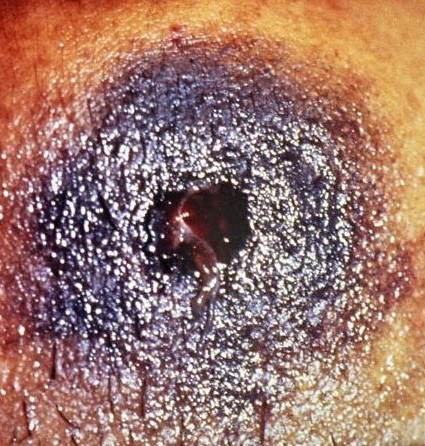
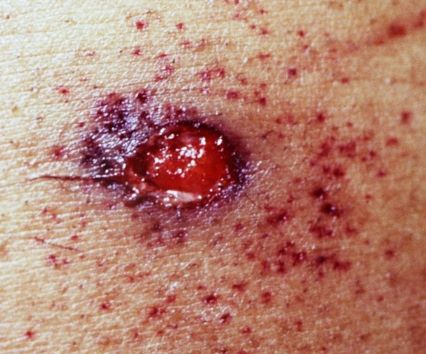
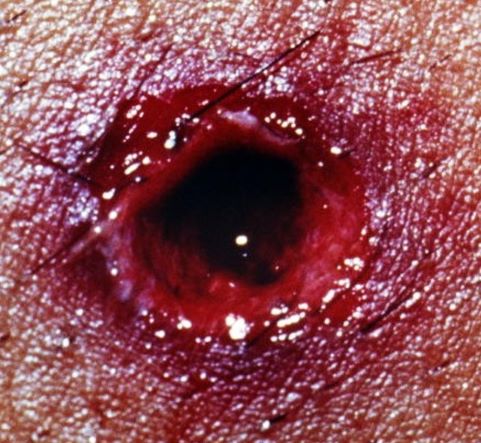
Pictures above are of different bullet wounds fired at different ranges
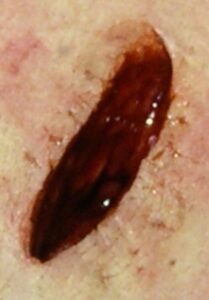 Cutting and stabbing – While less reliable than many of the indicia of close-range gunshot wounds, cutting and stabbing instruments may leave distinctive patterns suggesting their origin. Is the instrument a knife or something else, such as scissors, a screwdriver, a broken bottle, etc.? Is the knife in question single-bladed or double-bladed? For example, the wound depicted below was made by a single-bladed knife – sharp on one edge (top of image) and dull on the other edge (bottom of image). Think chef’s knife.
Cutting and stabbing – While less reliable than many of the indicia of close-range gunshot wounds, cutting and stabbing instruments may leave distinctive patterns suggesting their origin. Is the instrument a knife or something else, such as scissors, a screwdriver, a broken bottle, etc.? Is the knife in question single-bladed or double-bladed? For example, the wound depicted below was made by a single-bladed knife – sharp on one edge (top of image) and dull on the other edge (bottom of image). Think chef’s knife.
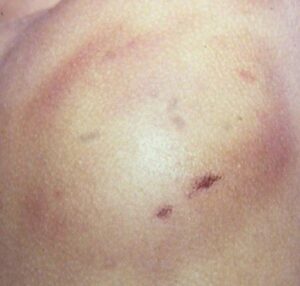
Blunt impact injury – Some blunt instruments leave behind very distinctive patterns that recapitulate their appearance on the skin surface. Occasionally, a pattern strongly suggests a class of, if not a specific instrument. Even without external evidence of injury, certain patterns of injury observed on and/or in the brain can suggest things such as vertex (top of the head) impact or fall versus inflicted trauma.
Postmortem toxicology
Our nation continues to be gripped by a veritable epidemic of opioid fatalities, with fentanyl the prime actor. As a result, there are many more “death resulting from” drug cases being presented to juries. It is essential to thoroughly evaluate the totality of the case where drug deaths are concerned, mainly when no one performed an autopsy. Postmortem drug concentrations must be interpreted in light of case circumstances and the mere presence of a given agent at a given concentration may or may not explain the death. Reliance on tables and charts of “lethal levels” is fraught with error, and the forensic pathologist can help walk through this murky territory.
These are but a few of the issues wherein a forensic pathology expert can assist in evaluating the medical evidence in your case. This consultation may bolster and corroborate your clinical specialty expert or raise issues requiring a closer look or re-evaluation. In either case, your understanding of the case will be enhanced and you will enter mediation or trial well-informed and prepared.


